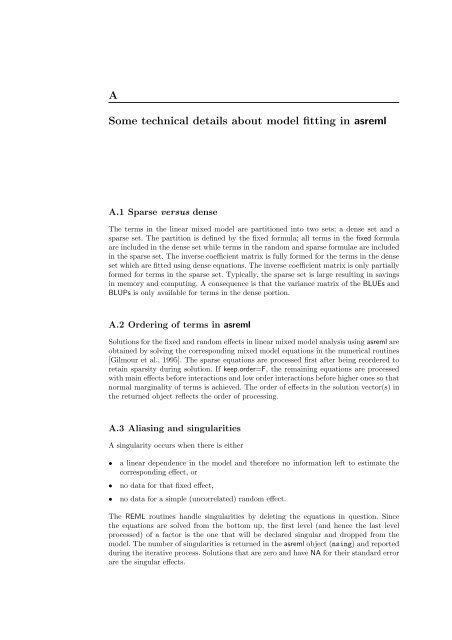ASReml-S reference manual - VSN International
ASReml-S reference manual - VSN International
ASReml-S reference manual - VSN International
- No tags were found...
You also want an ePaper? Increase the reach of your titles
YUMPU automatically turns print PDFs into web optimized ePapers that Google loves.
ASome technical details about model fitting in asremlA.1 Sparse versus denseThe terms in the linear mixed model are partitioned into two sets; a dense set and asparse set. The partition is defined by the fixed formula; all terms in the fixed formulaare included in the dense set while terms in the random and sparse formulae are includedin the sparse set. The inverse coefficient matrix is fully formed for the terms in the denseset which are fitted using dense equations. The inverse coefficient matrix is only partiallyformed for terms in the sparse set. Typically, the sparse set is large resulting in savingsin memory and computing. A consequence is that the variance matrix of the BLUEs andBLUPs is only available for terms in the dense portion.A.2 Ordering of terms in asremlSolutions for the fixed and random effects in linear mixed model analysis using asreml areobtained by solving the corresponding mixed model equations in the numerical routines[Gilmour et al., 1995]. The sparse equations are processed first after being reordered toretain sparsity during solution. If keep.order=F, the remaining equations are processedwith main effects before interactions and low order interactions before higher ones so thatnormal marginality of terms is achieved. The order of effects in the solution vector(s) inthe returned object reflects the order of processing.A.3 Aliasing and singularitiesA singularity occurs when there is either• a linear dependence in the model and therefore no information left to estimate thecorresponding effect, or• no data for that fixed effect,• no data for a simple (uncorrelated) random effect.The REML routines handle singularities by deleting the equations in question. Sincethe equations are solved from the bottom up, the first level (and hence the last levelprocessed) of a factor is the one that will be declared singular and dropped from themodel. The number of singularities is returned in the asreml object (nsing) and reportedduring the iterative process. Solutions that are zero and have NA for their standard errorare the singular effects.
















